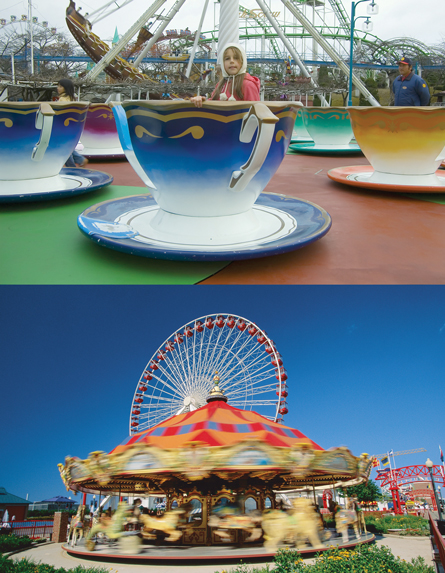Module 5—Circular Motion
Lesson 1—Understanding Circular Motion
 Get Focused
Get Focused

top: © Ilya D. Gridnev/shutterstock
bottom: Photodisc/Getty Images
Going in circles, it seems, is fun. Consider all the rides you find at a local carnival or fair. Nearly every ride involves circular motion. Some rides move in the horizontal plane, such as the teacups ride, which is pictured here; others move in a vertical plane, such as the Ferris wheel and the Tidal Wave (pictured behind the teacups). Other rides move with a combination of vertical and horizontal motions, such as the roller coaster.
Why do all the rides involve some sort of circular motion? What makes this type of motion so much fun?
Consider taking a ride on the Polar Express. Riders sit side by side on a flat bench seat. As the ride begins to spin faster, the riders slide across the bench seat, to the point where the rider on the left gets squished by the others. The “squishing” force is real and continuous, accelerating the riders constantly yet never changing their speed. Then the ride slows, the force decreases, and the riders are able to slide back to their original seats.
What is the nature of the “squishing” force? How is it related to the velocity of the rider and controlled by the ride operator and the ride designer? The answer to these questions is related to an understanding of inward force and its relationship with radius, mass, and velocity.
As you work through this lesson, keep these questions in mind:
- How do Newton’s first and second laws apply to circular motion?
- What factors affect acceleration during circular motion?
 Module 5: Lesson 1 Assignments
Module 5: Lesson 1 Assignments
Your teacher-marked Module 5: Lesson 1 Assignment requires you to submit a response to the following:
- Try This—TR 1, TR 2, TR 3, and TR 4
- Lab–LAB 1, LAB 2, LAB 3, LAB 4, LAB 5, LAB 6, LAB 7, LAB 8, and LAB 9
The other questions in this lesson are not marked by the teacher; however, you should still answer these questions. The Self-Check and Try This questions are placed in this lesson to help you review important information and build key concepts that may be applied in future lessons.
After a discussion with your teacher, you must decide what to do with the questions that are not part of your assignment. For example, you may decide to submit to your teacher the responses to Try This questions that are not marked. You should record the answers to all the questions in this lesson and place those answers in your course folder.